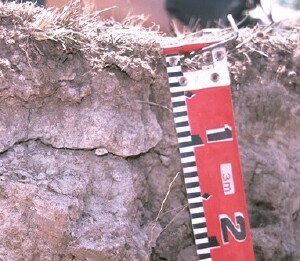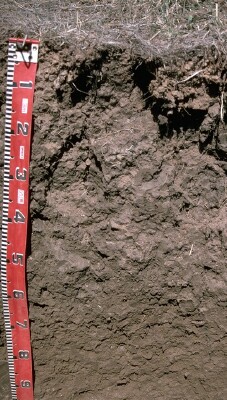GN19
| Group: Nagambie Landcare Group | Australian Soil Classification: Episodic, Epipedal, Brown VERTOSOL. |
| Northcote Factual Key:Ug 5.2 / Ug 2 intermixed | Great Soil Group: brown clay |
| General Landscape Description: Drainage depression within an alluvial plain which originally supported River Red Gum (Eucalyptus camaldulensis). | |
 GN19 Landscape |  Section of discontinuous bleached A2 horizon |
Soil Profile Morphology
Surface Soil
| A1 | 0-10 cm | Dark greyish brown (10YR4/2); medium heavy clay; rusty root channel mottling; moderate coarse blocky structure; strong consistence dry; pH 5.7; clear change to: |  GN19 Profile |
| A2 | 10-15 cm | Pale brown (10YR6/3) conspicuously bleached (10YR8/1d); fine sandy clay loam; discontinuous and variable in depth; pH 6.3: | |
| Subsoil | |||
| B21 | 15-50 cm | Brown (10YR5/3); medium heavy clay; very coarse prismatic, breaking down to moderate coarse polyhedral structure; very strong consistence dry; pH 7.5; gradual change to: | |
| B22 | 50-90 cm | Brown (10YR5/3); medium heavy clay; moderate very coarse lenticular structure (with shiny faced peds and slickensides); very firm consistence moist; pH 8.0; gradual change to: | |
| B23 | 90+ cm | Yellowish brown (10YR5/4); medium heavy clay; contains a slight (2-5%) amount of gypsum; pH 7.7. | |
| This soil occurs within the Wormangal Wetland Clays soil/geomorphic unit mapped by Skidmore (1993). | |||
Key Profile Features
- Surface cracking.
- Clay texture throughout the profile.
- Slickensides at depth in the profile.
Key Profile Characteristics
pH | Salinity Rating | |||
Surface (A1 horizon) | moderately acid | very low | sodic | slight1 |
Subsoil (B21 horizon) | slightly alkaline | very low | sodic | strong |
Deeper subsoil (at 1 m) | slightly alkaline | high | strongly sodic | strong |
| 1 Moderate dispersion after remoulding. | ||||
 |
Management Considerations:
Whole Profile
- Plant Available Water Capacity is low (estimated at 93mm) for this profile - based on the laboratory data available. PAWC is limited by the sodic subsoil and increased salinity with depth.
Surface (A) Horizons
- The surface horizon is sodic and disperses slightly. The infiltration ratio will be relatively slow after rain. Moderate dispersion may also occur if the soil is cultivated or overstocked when wet, and crusting may result on drying. Furthermore, the calcium:magnesium ratio is low which will also make the soil conducive to structural degradation. A calcium deficiency may also occur.
- The high wilting point value (16%) means that plants will not be able to fully utilise light rains falling on relatively dry soil.
Subsoil (B) Horizons
- The soil salinity rating becomes medium to high after 50 cm depth. This may restrict the growth of deeper rooted salt sensitive species.
- The subsoil is sodic and strongly dispersive (and has a low calcium:magnesium ratio of 0.4). This is likely to restrict water and root movement through the profile. The presence of a discontinuous bleach, as well as rusty root channel mottling in the surface horizon, suggests that water movement is being restricted by the B21 horizon.

